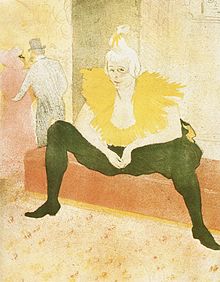Cha-U-Kao
Appearance
Cha-U-Kao | |
|---|---|
 The Seated Clowness by Henri de Toulouse-Lautrec | |
| Nationality | French |
| Other names | The Clowness |
| Occupation(s) | dancer, acrobat, clown |
Cha-U-Kao was the name of a French entertainer who performed at the Moulin Rouge and the Nouveau Cirque in the 1890s. Her stage name was also the name of a boisterous popular dance, similar to the can-can, which came from the French words "chahut", meaning 'noise' and "chaos". [1] [2] She was depicted in a series of paintings by Henri de Toulouse-Lautrec. Cha-U-Kao soon became one of his favorite models. The artist was fascinated by this woman who dared to choose the classic male profession of clowning and was not afraid to openly declare that she was a lesbian.
Wikimedia Commons has media related to Cha-U-Kao.
Sources
- ^ Lisa Mintz Messinger, Magdalena Dabrowski, Stieglitz and His Artists: Matisse to O'Keeffe : the Alfred Stieglitz Collection in the Metropolitan Museum of Art, Metropolitan Museum of Art (New York, N.Y.), Metropolitan Museum of Art, 2011
- ^ "Henri de Toulouse-Lautrec: The Seated Clowness (Mademoiselle Cha-u-Kao) (49.55.50) | Heilbrunn Timeline of Art History | The Metropolitan Museum of Art". metmuseum.org. Retrieved 2014-06-12.
